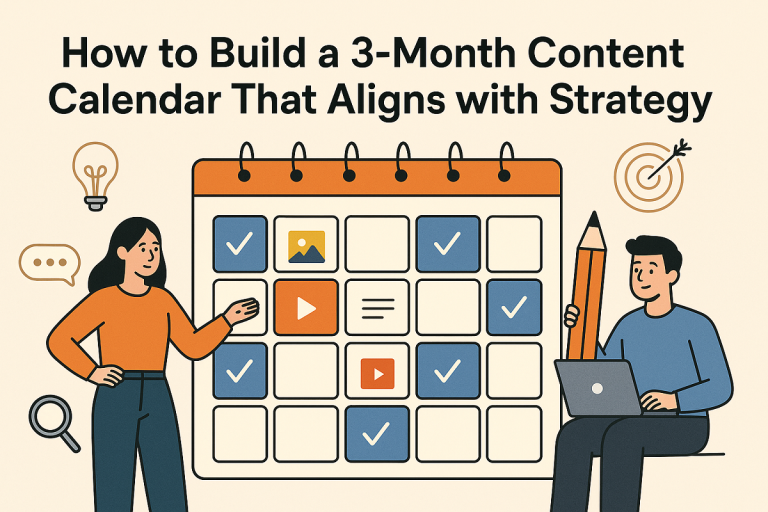If you’ve ever struggled to stay consistent with your content marketing efforts, you’re not alone. Many businesses find themselves scrambling for ideas or posting sporadically without a clear direction. That’s where a 3-month content calendar becomes invaluable. Whether you’re working solo or with a content marketing agency in Melbourne, a well-planned calendar can keep your team aligned, your message consistent, and your content performance-driven.
In this blog, we’ll walk you through how to build a strategic 3-month content calendar step by step — ensuring each piece of content aligns with your broader business goals.
Why a 3-Month Calendar?
A quarterly content calendar strikes a balance between flexibility and long-term planning. It’s long enough to give you strategic direction, yet short enough to adapt to market shifts or new opportunities. A 3-month view also allows you to create thematic campaigns and align content across channels for maximum impact.
Define Your Content Goals
Start by identifying your overarching goals for the next three months. These might include:
- Generating more leads
- Increasing brand awareness
- Driving traffic to your website
- Supporting a product launch
- Building authority in your industry
Your goals should directly inform the topics, formats, and publishing frequency you plan for. For example, if lead generation is a priority, you might want to focus on gated content like eBooks, case studies, or webinars.
Understand Your Audience
Before creating any content, make sure you understand who you’re talking to. Develop or refine your buyer personas to reflect key demographics, pain points, interests, and preferred content formats.
Ask yourself:
- What questions does my audience have?
- What type of content do they engage with most?
- Where do they consume content (blog, YouTube, LinkedIn, etc.)?
Understanding your audience ensures that your content calendar isn’t just full — it’s filled with content that actually resonates.
Conduct a Content Audit
Before planning new content, audit your existing assets. A content audit can help you:
- Identify top-performing content you can repurpose
- Find gaps in your topic coverage
- Determine what needs updating or optimizing
This step helps you avoid duplication and ensures you’re building on what already works.
Choose Your Content Themes
Now that you know your goals and audience, choose 2–3 main themes to focus on during the quarter. Themes create consistency and make it easier to brainstorm related topics.
For example, a cybersecurity company might choose:
- Cyber threat prevention
- Regulatory compliance
- Employee awareness training
These themes can then be broken down into blog posts, videos, social media snippets, infographics, or email content throughout the 3-month period.
Plan Your Content Mix
Diversify your formats based on your audience’s preferences and your content goals. A balanced mix might include:
- Blog articles (SEO-focused or thought leadership)
- Social media posts (brand awareness and engagement)
- Email newsletters (nurturing and updates)
- Long-form assets (whitepapers, guides, case studies)
- Videos or webinars (explainer or educational)
Collaborating with a content marketing agency Sydney can help you fine-tune your mix based on performance data and trends within your industry.
Map Out Your Calendar
Now it’s time to actually build the calendar. A simple spreadsheet or a tool like Trello, Asana, or Airtable works well. Include the following columns:
- Publish Date
- Title/Topic
- Content Type (e.g., blog, video, infographic)
- Target Persona
- Channel (e.g., website, LinkedIn, email)
- Owner (writer, designer, approver)
- Call to Action (CTA)
Space your content out based on your capacity. For example, you might publish:
- 1 blog post per week
- 3–5 social posts per week
- 1 email newsletter every two weeks
Be realistic. It’s better to have consistent, high-quality content than to overcommit and underdeliver.
Incorporate SEO and Keywords
As you finalize your content ideas, integrate keyword research into the planning process. Use tools like SEMrush, Ahrefs, or Google Keyword Planner to identify high-volume, low-competition keywords that align with your themes.
Every piece of content should target one primary keyword and a few secondary ones. This will help increase visibility in search engines and attract the right traffic over time.
Set Up a Review Process
Building your calendar is just the beginning. You need a system for reviewing and optimizing your content strategy each month.
Include monthly checkpoints to:
- Review performance metrics (traffic, engagement, conversions)
- Adjust the next month’s content based on results
- Update the calendar with new ideas or relevant trends
Analytics platforms like Google Analytics, HubSpot, and social media insights will help you understand what’s working and what’s not.
Building a 3-month content calendar that aligns with strategy doesn’t have to be overwhelming. With a clear understanding of your goals, audience, and resources, you can design a calendar that keeps your brand visible, relevant, and valuable to your audience. If you’re unsure where to start or want expert support, partnering with a content marketing agency can simplify the process and help you achieve better results, faster.


